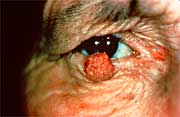|

Cancers of the Eyelid
Cancers of the skin of the eyelid are fairly common.
  Basal
cell carcinoma Basal
cell carcinoma
Over 90% of all malignant eyelid tumors are basal cell carcinomas
(BCCA). The lower eyelids are primarily involved in over 70% of
cases, followed by the medial canthus, upper eyelid, and lateral
canthus. BCCA usually presents as small firm raised nodules with
an ulcerated center with rolled pearly translucent margins with
fine telangiectatic vessels. This type of cancer causes extensive
local destruction and can recur locally, if inadequately excised.
However, these tumors generally do not metastasize to lymph nodes
or distant organs.
Squamous cell carcinoma  
This form of skin cancer occurs less frequently than basal cell
carcinoma but it is more aggressive. It can metastasize to regional
lymph nodes and even produce systemic metastasis. Wide excision
of these tumors is the primary treatment. Sometimes when there is
extensive involvement or adequate margins are not obtained, radiation
therapy or other treatment modalities may be used
  Malignant
melanoma of the eyelid skin Malignant
melanoma of the eyelid skin
This is a relatively rare cancer of the eyelid and accounts for
about 1% of all eyelid malignancies. As with cutaneous melanomas
elsewhere in the body, these lesions appear pigmented and show growth
and change in borders with time. The principles of treatment for
malignant melanoma in other locations apply for malignant melanoma
of the eyelid skin as well. The tumor thickness should be identified
via a biopsy. That usually determines the required margin of resection.
The thicker a tumor (on histopathologic sections) the higher the
likelihood of local recurrence and distant metastasis. Complete
surgical excision of these tumors with 5-10 mm margins is recommended.
The patient also needs to have periodic chest X-rays and other laboratory
studies to rule out distant metastasis.
Meibomian gland carcinoma
This is another rare type of cancer involving the eyelids. It
primarily affects the meibomian glands of the eyelids. These are
sebaceous glands that normally produce the oily layer of the tear
film. Meibomian gland carcinomas can be mistaken with some benign
conditions such as a chalazion (or more commonly known as a "sty").
Any "sty" that does not heal and resolve with medical treatment
or surgical drainage should be biopsied to rule out meibomian gland
carcinoma. The treatment of meibomian gland carcinoma consists of
surgical excision and long-term monitoring for regional lymph node
or distant metastasis.
Reconstructive surgery can be performed after excision of most
eyelid cancers and usually leads to acceptable functional and cosmetic
outcomes. This is best done by an ophthalmic plastic surgeon (oculoplastic
surgeon). This type of surgeon is an ophthalmologist who has special
training in plastic surgery of the eyelids and periocular tissues
as well as surgery of the lacrimal drainage system and the orbit.
|



